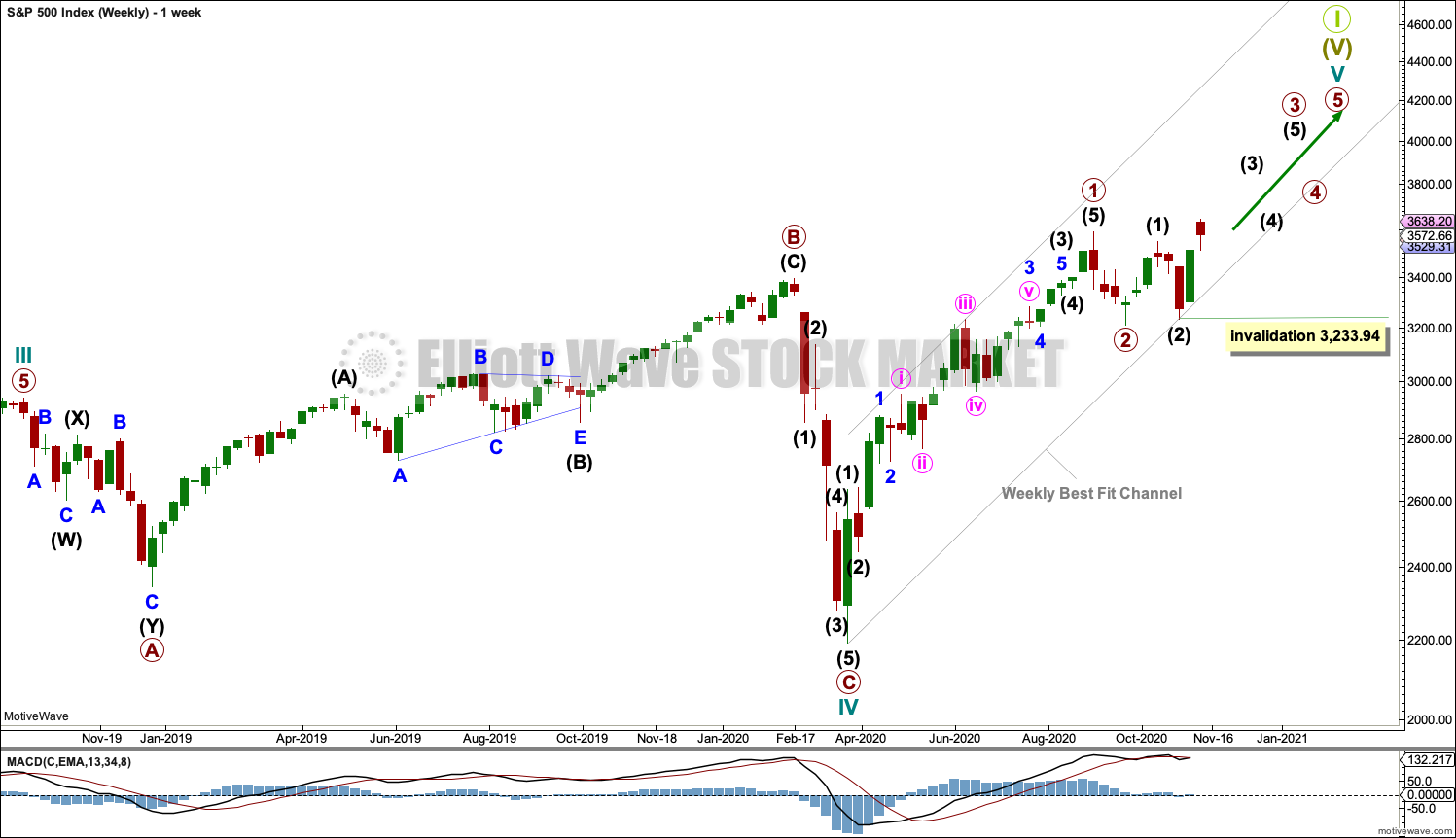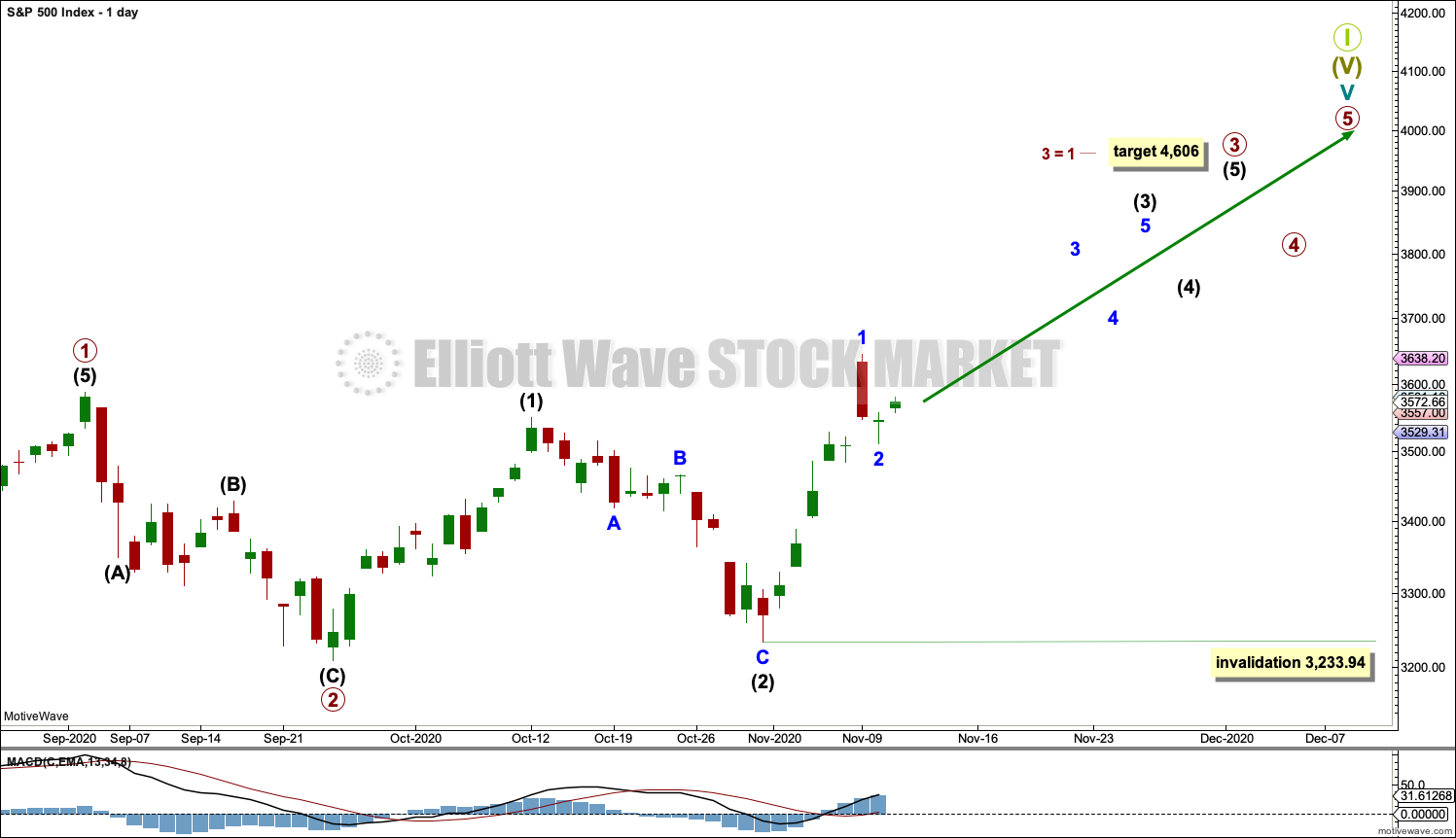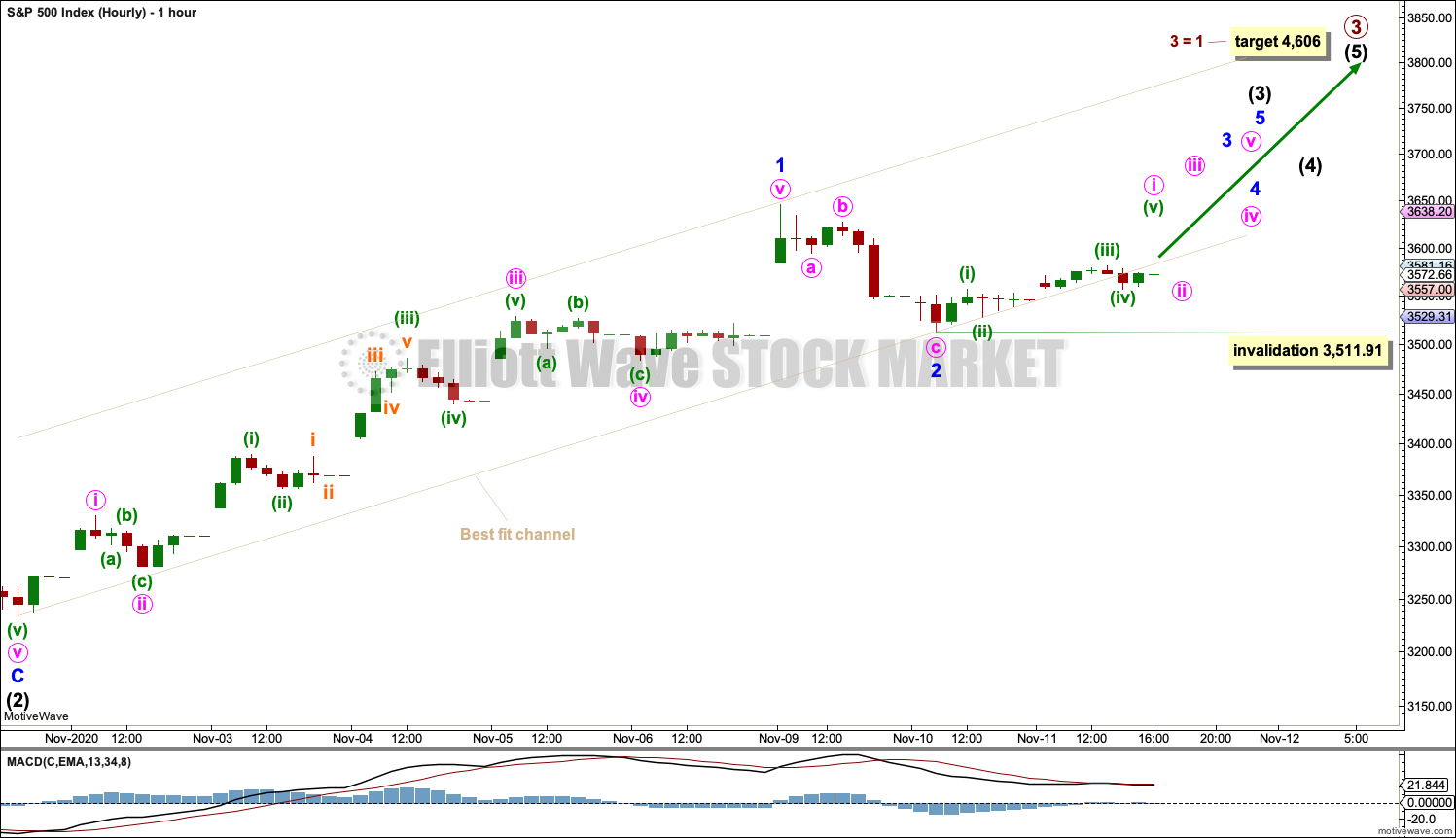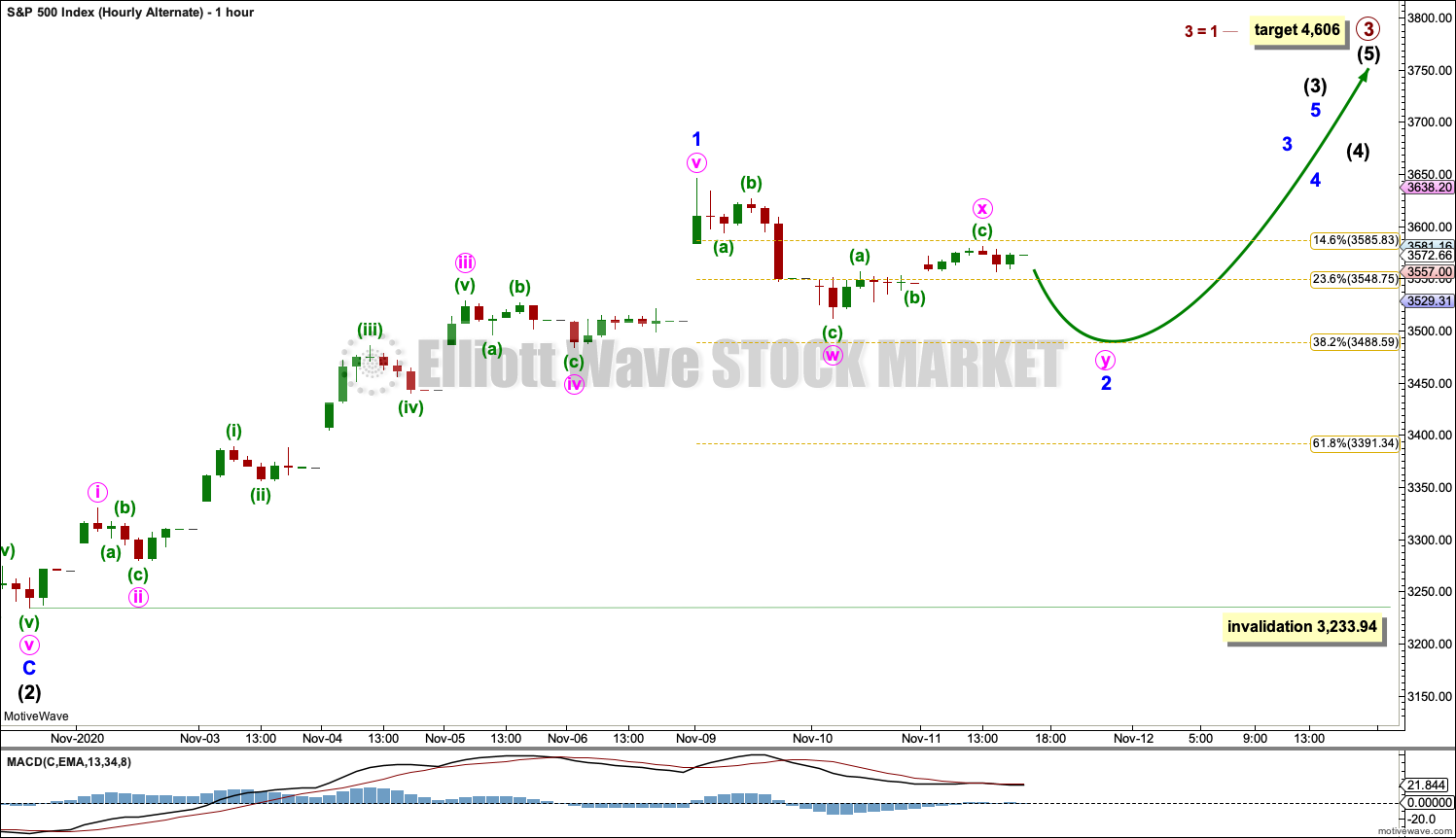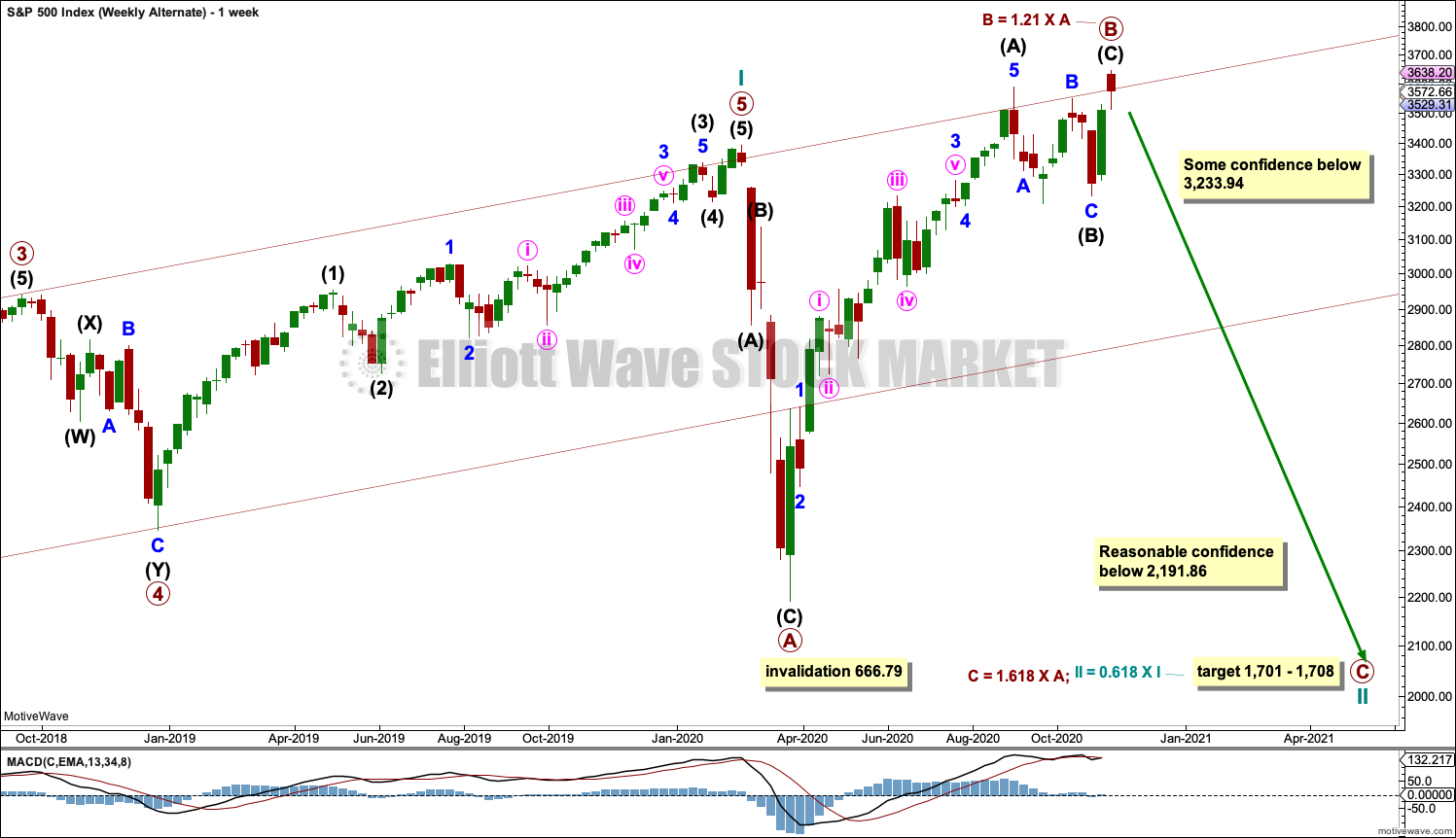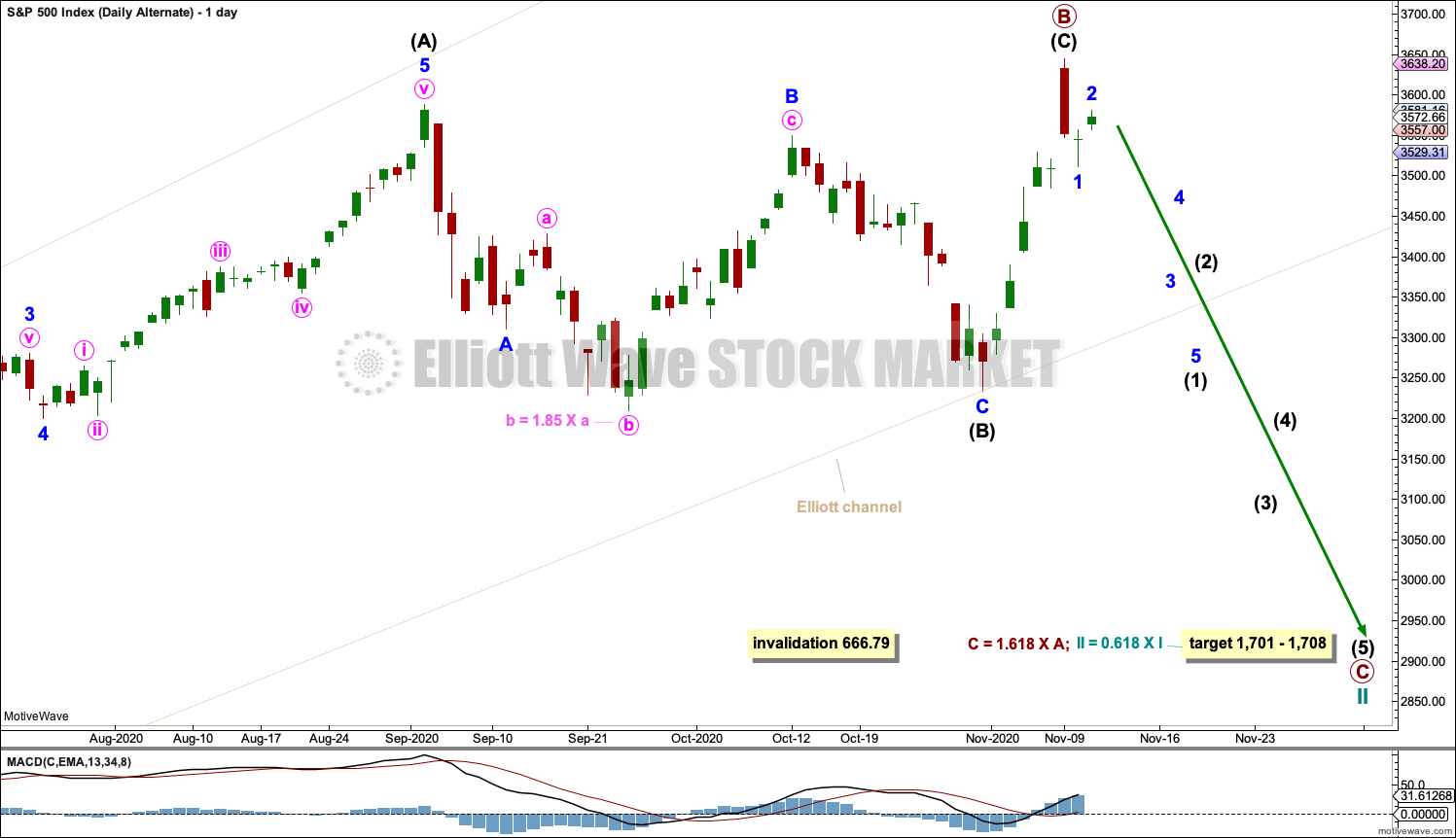S&P 500: Elliott Wave and Technical Analysis | Charts – November 11, 2020
A very small range day sees price move slightly higher.
Both short-term hourly Elliott wave counts remain valid.
Summary: The main wave count expects a low is now in. The target is at 4,606 and an invalidation point at 3,209.45.
If the main wave count is invalidated with a new low below 3,233.94 and then 2,191.86, then an alternate may be used. This wave count is very bearish. It expects a strong wave down to a target at 1,708. The invalidation point is 666.76.
The biggest picture, Grand Super Cycle analysis, is here.
Monthly charts are last updated here with video here.
ELLIOTT WAVE COUNTS
MAIN WAVE COUNT
WEEKLY CHART
Cycle wave V may last from one to several years. So far it is in its eighth month.
This wave count may allow time for the AD line to diverge from price as price makes final highs before the end of the bull market. The AD line most commonly diverges a minimum of 4 months prior to the end of a bull market.
Cycle wave V would most likely subdivide as an impulse. But if overlapping develops, then an ending diagonal should be considered. This chart considers the more common impulse.
Primary waves 1 and 2 may be complete.
Primary wave 3 may only subdivide as an impulse.
There is already a Fibonacci ratio between cycle waves I and III within Super Cycle wave (V). The S&P500 often exhibits a Fibonacci ratio between two of its actionary waves but rarely between all three; it is less likely that cycle wave V would exhibit a Fibonacci ratio. The target for Super Cycle wave (V) to end would best be calculated at primary degree, but that cannot be done until all of primary waves 1, 2, 3 and 4 are complete.
DAILY CHART
Primary waves 1 and 2 may both be complete. Primary wave 3 may now be underway.
Primary wave 3 may only subdivide as an impulse. Within primary wave 3: Intermediate waves (1) and (2) may both be complete, and intermediate wave (3) may now be underway and may only subdivide as an impulse.
No second wave correction within intermediate wave (3) may move beyond the start of its first wave below 3,233.94.
Primary wave 1 looks extended. The target for primary wave 3 expects it to also be extended.
HOURLY CHART
Intermediate wave (3) may only subdivide as an impulse at minor degree.
Minor waves 1 and 2 within intermediate wave (3) may be complete. A third wave up at three degrees may now begin. This wave count expects an increase in upwards momentum.
Minor wave 3 may only subdivide as an impulse. Minute wave ii within minor wave 3 may not move beyond the start of minute wave i below 3,511.91.
Bullish divergence between price and both of the AD line and VIX, and support from volume for upwards movement within the last two sessions, offer some technical support to this main wave count. For these reasons it is judged to have a higher probability than the alternate hourly wave count immediately below.
ALTERNATE HOURLY CHART
This alternate wave count only moves the degree of labelling within minor wave 2 down one degree. Minor wave 2 may continue lower as a double zigzag to end closer to the 0.382 Fibonacci ratio of minor wave 1.
If price reaches the 0.382 Fibonacci ratio and keeps falling, then the next target would be the 0.618 Fibonacci ratio.
Minor wave 2 may not move beyond the start of minor wave 1 below 3,233.94.
ALTERNATE WAVE COUNT
WEEKLY CHART
To view the material difference between the main and this alternate wave count, monthly charts should be viewed. There is a link to charts, text and video analysis of monthly charts at the top of this analysis.
Cycle wave II may be subdividing as an expanded flat. Primary wave B within the expanded flat is a 1.21 length of primary wave A, which is within the most common range for B waves within flats of up to 1.38. Expanded flats are reasonably common structures.
A 7 point target zone is calculated at two wave degrees.
Cycle wave II may not move beyond the start of cycle wave I below 666.79.
DAILY CHART
Primary wave B may be complete as a zigzag at today’s high. Primary wave C may now begin and must subdivide as a five wave motive structure, most likely an impulse.
Cycle wave II may not move beyond the start of cycle wave I below 666.79.
There is no upper invalidation point for this wave count; primary wave B could continue higher as a double zigzag. The common range for B waves within flat corrections is from 1 to 1.38 times the length of their corresponding A waves. This gives a range within primary wave B that may continue up to 3,850.15. Prior to this price point being reached, it may be possible to discard this alternate wave count based upon technical analysis.
TECHNICAL ANALYSIS
WEEKLY CHART
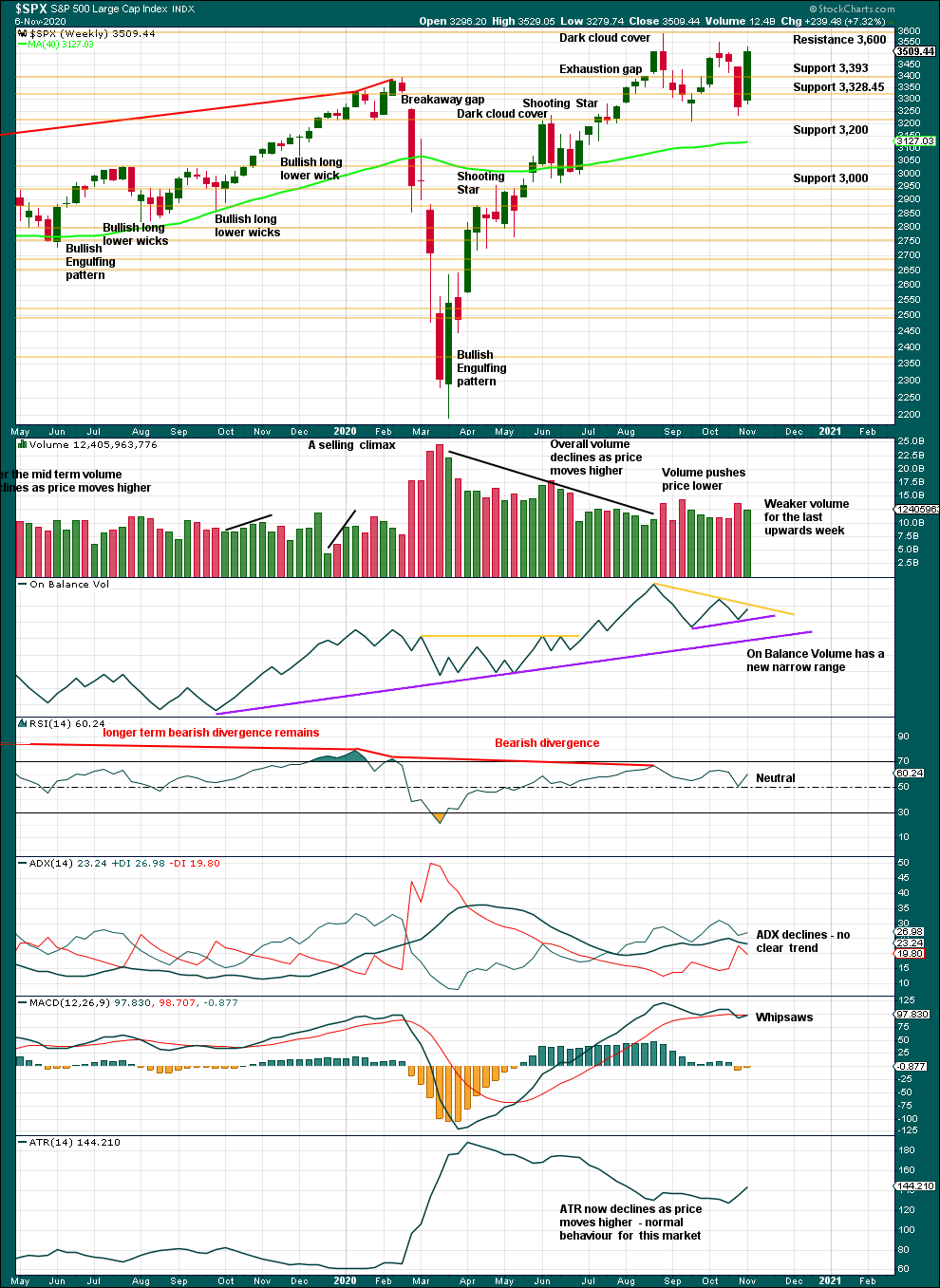
Click chart to enlarge. Chart courtesy of StockCharts.com.
A strong upwards week with strong range sees price remain within a consolidation zone. Resistance is about 3,590 to 3,600. Support is about 3,200. A breakout is required for confidence in the next direction. At this stage, there has not yet been a breakout. A breakout requires a close above resistance at 3,588.11.
DAILY CHART
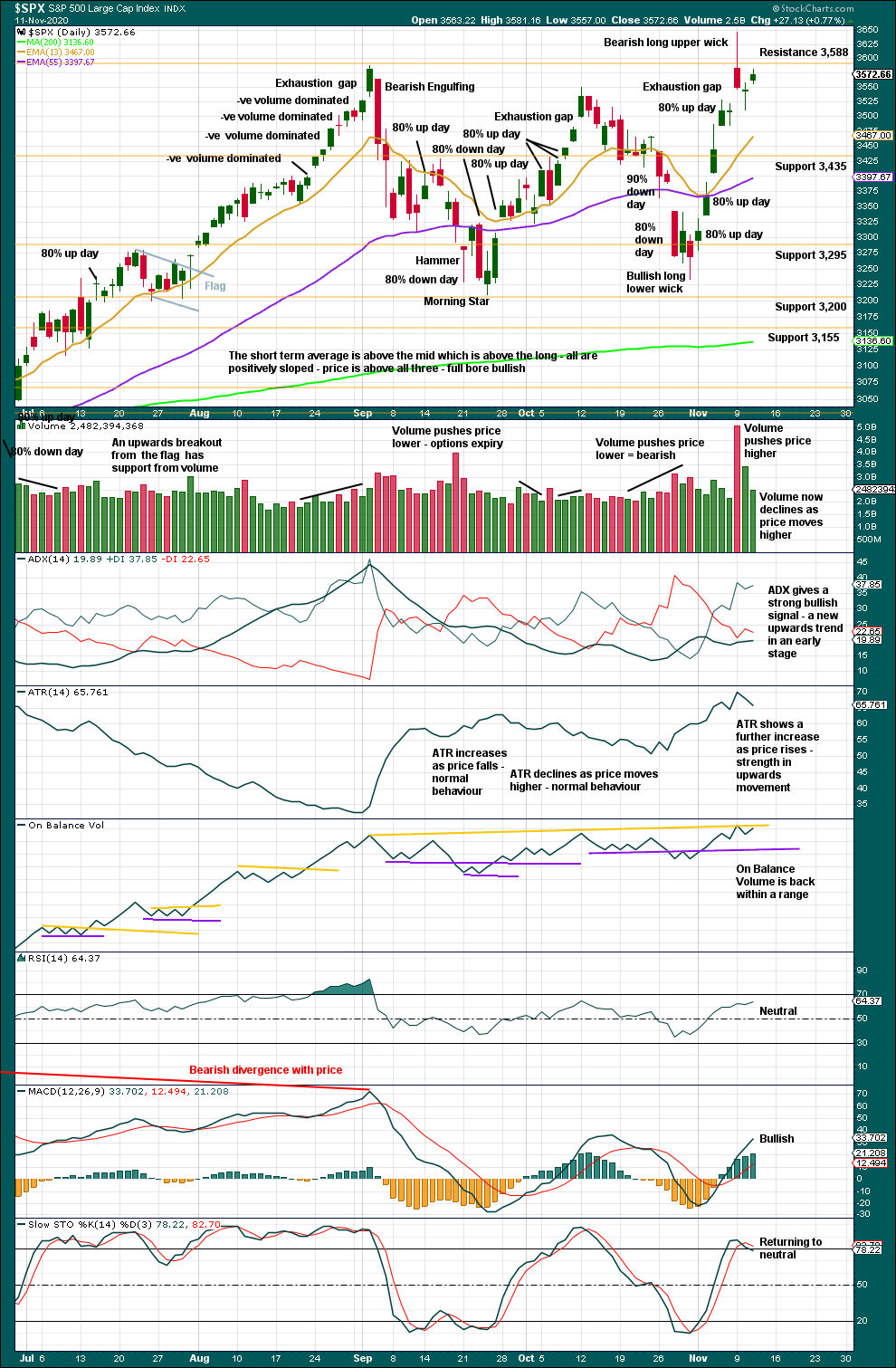
Click chart to enlarge. Chart courtesy of StockCharts.com.
The gap is closed, so it is renamed an exhaustion gap. A pullback may develop from here.
ADX indicates a trend. Resistance needs to be overcome before confidence that the consolidation is over may be had. This means that price needs to close above the prior all time high at 3,588.11 before we can have confidence that it will keep going up and not continue in the large sideways range price has been in since early September.
BREADTH – AD LINE
WEEKLY CHART
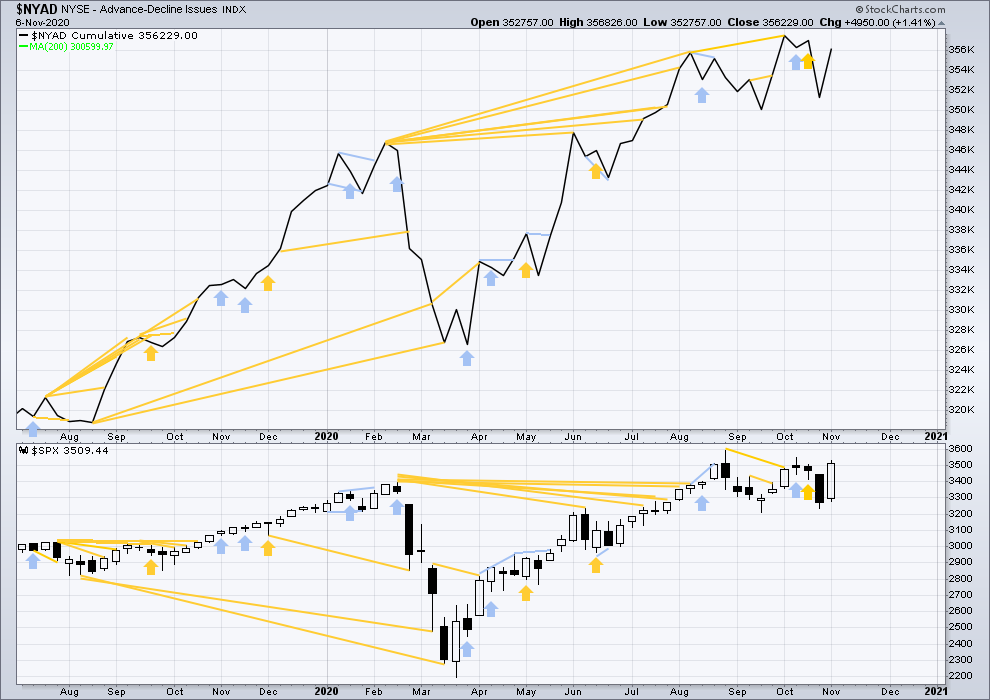
Click chart to enlarge. Chart courtesy of StockCharts.com. So that colour blind members are included, bearish signals will be noted with blue and bullish signals with yellow.
Breadth should be read as a leading indicator.
Lowry’s Operating Companies Only AD line has made a new all time high on the 12th of October. This erases prior bearish divergence with the last all time high in January 2020. With both the NYSE and OCO AD lines making new all time highs, breadth is leading price. This is a strong bullish signal and supports the main Elliott wave count.
Large caps all time high: 3,645.99 on November 9, 2020.
Mid caps all time high: 2,162.80 on November 9, 2020.
Small caps all time high: 1,100.58 on August 27, 2018.
Last week both price and the AD line have moved higher. Neither has made new short-term swing highs. There is no new divergence.
DAILY CHART
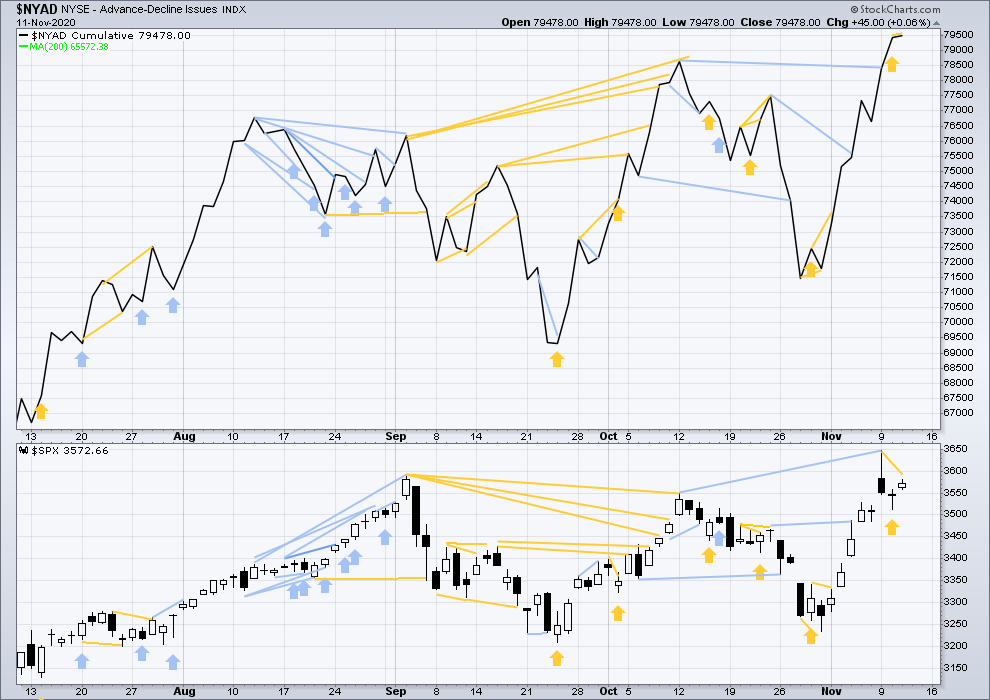
Click chart to enlarge. Chart courtesy of StockCharts.com. So that colour blind members are included, bearish signals will be noted with blue and bullish signals with yellow.
Today the AD line has made a new all time high, but price has not. This divergence is bullish and supports the main hourly Elliott wave count.
VOLATILITY – INVERTED VIX CHART
WEEKLY CHART
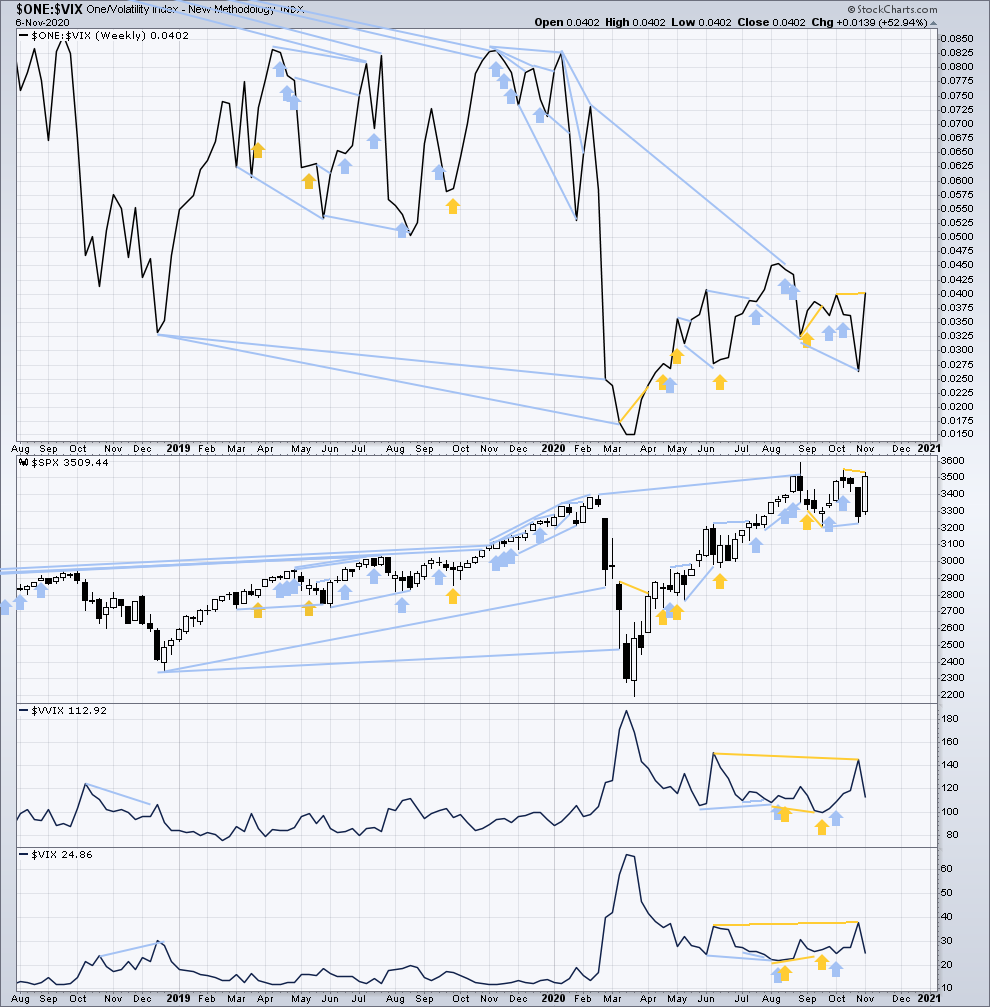
Click chart to enlarge. Chart courtesy of StockCharts.com. So that colour blind members are included, bearish signals will be noted with blue and bullish signals with yellow.
Inverted VIX remains well below all time highs. The all time high for inverted VIX was in the week beginning October 30, 2017. There is over 3 years of bearish divergence between price and inverted VIX. There is all of long, mid and short-term bearish divergence. This supports the second alternate Elliott wave count.
Last week price and inverted VIX have moved higher. Inverted VIX has made a very slight new high above the prior swing high, but price has not. This divergence is bullish for price, but it is very weak.
Comparing VIX and VVIX: Both VIX and VVIX have moved higher. VIX has made a new high above the prior high of the 8th of June, but VVIX has not. This divergence is bullish for price and may support either the main or first alternate Elliott wave counts.
DAILY CHART
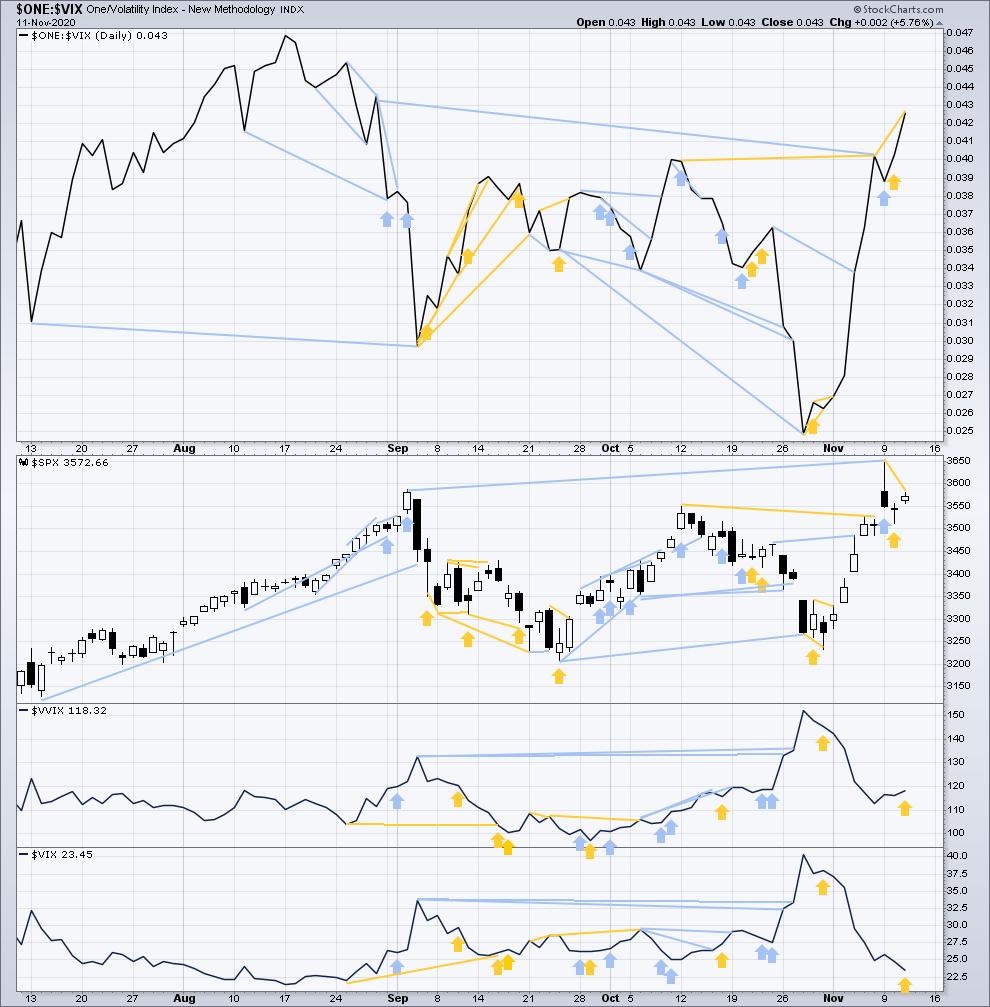
Click chart to enlarge. Chart courtesy of StockCharts.com. So that colour blind members are included, bearish signals will be noted with blue and bullish signals with yellow.
Bullish divergence has been followed by an upwards session, so it may be resolved.
Today inverted VIX has made a new short-term high, but price has not. This divergence is bullish for the short term.
Comparing VIX and VVIX at the daily chart level: Today VIX has moved lower, but VVIX has moved higher. This divergence is bullish for price for the short term.
DOW THEORY
Dow Theory still concludes a bear market is in place.
Dow Theory confirmed a bear market with the following lows made on a closing basis:
DJIA: 21,712.53 – a close below this point was been made on the March 12, 2020.
DJT: 8,636.79 – a close below this point was been made on March 9, 2020.
Adding in the S&P and Nasdaq for an extended Dow Theory, a bear market was confirmed:
S&P500: 2,346.58 – a close below this point was made on March 20, 2020.
Nasdaq: 7,292.22 – a close below this point was made on the March 12, 2020.
At this time, to shift Dow Theory from viewing a bear market to confirmation of a new bull market would require new highs made on a closing basis:
DJIA: 29,568.57 – while DJIA made a new high above this point today, it has not closed above this point. Dow theory requires a close.
DJT: 11,623.58 – closed above on 7th October 2020.
Adding in the S&P and Nasdaq for an extended Dow Theory, confirmation of a bull market would require new highs made on a closing basis:
S&P500: 3,393.52 – closed above on 21st August 2020.
Nasdaq: 9,838.37 – closed above on June 8, 2020.
Published @ 06:11 p.m. ET.
—
Careful risk management protects your trading account(s).
Follow my two Golden Rules:
1. Always trade with stops.
2. Risk only 1-5% of equity on any one trade.
—
New updates to this analysis are in bold.

